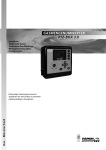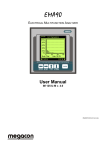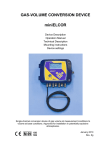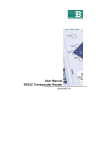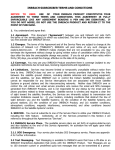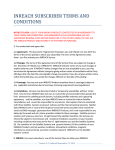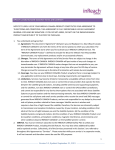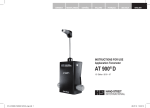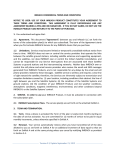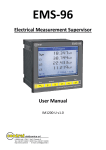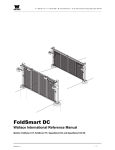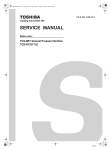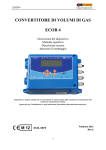Download GAS-CADA
Transcript
GAS-CADA High level electronic volume converter Gas - Measurement Installation, Operation and Maintenance Manual (IOM) GAS-CADA vemm tec Installation, Operation, and Maintenance Manual (IOM) CONTENTS 1 LIST OF TERMS AND SYMBOLS ........................................................................................................ 5 2 2.1 2.2 2.3 2.4 2.5 2.6 2.7 2.8 2.8.1 2.8.2 2.9 2.10 2.10.1 2.10.2 2.11 2.11.1 2.11.2 2.11.3 2.11.4 2.11.5 2.11.6 2.11.7 2.12 2.12.1 2.12.2 2.12.3 2.12.4 2.13 2.14 2.14.1 2.14.2 2.15 2.15.1 2.15.2 2.15.3 2.15.4 2.16 INTRODUCTION................................................................................................................................... 6 Dear customer....................................................................................................................................... 6 Notice .................................................................................................................................................... 6 Brief description..................................................................................................................................... 6 Parts and documents supplied with the GAS-CADA............................................................................. 8 Instructions for storage and conservation ............................................................................................. 9 Principle of operation: Calculation of the gas conversion factor C........................................................ 9 Volume under error conditions ............................................................................................................ 10 Mechanical design............................................................................................................................... 11 Protection against electromagnetic interference - EMC and EMI........................................... 11 Explosion-proof design: „i“ variant and „i/n“ variant ................................................................ 12 Block diagram of the device ................................................................................................................ 12 Keyboard and display .......................................................................................................................... 13 Display characteristics............................................................................................................ 13 Description of individual keys ................................................................................................. 13 System menu ...................................................................................................................................... 13 Basic menu............................................................................................................................. 15 Actual values .......................................................................................................................... 15 Saved values .......................................................................................................................... 15 Device parameters ................................................................................................................. 15 System data............................................................................................................................ 16 Diagnostics ............................................................................................................................. 16 Error messages ...................................................................................................................... 16 Parameters.......................................................................................................................................... 17 Analog values ......................................................................................................................... 17 Digital inputs ........................................................................................................................... 17 Digital outputs......................................................................................................................... 18 Digits on the display................................................................................................................ 18 Data archives ...................................................................................................................................... 18 Communication with a master system ................................................................................................ 20 Communication with a modem controlled by AT commands ................................................. 20 Communication with GSM and GPRS modems..................................................................... 20 Protection against changes of metrological parameters ..................................................................... 20 Protection realized by switches .............................................................................................. 20 Password system and access levels ...................................................................................... 21 Saving changes into the setting archive ................................................................................. 21 Device identification and official seals .................................................................................... 22 Extending the device with additional transmitters and modules.......................................................... 23 3 3.1 3.1.1 3.1.2 3.2 SOFTWARE........................................................................................................................................ 24 Firmware ............................................................................................................................................. 24 Additional firmware options .................................................................................................... 24 Updating firmware .................................................................................................................. 24 Factory settings ................................................................................................................................... 24 Page 2 GAS-CADA_IOM_07.doc IOM / January 2007 GAS-CADA vemm tec 4 4.1 4.2 4.2.1 4.2.2 4.2.3 4.3 4.3.1 4.3.2 4.3.3 4.3.4 4.4 4.4.1 4.4.2 4.5 4.6 4.7 4.8 4.8.1 4.8.2 4.8.3 4.8.4 4.8.5 4.8.6 4.9 INSTALLATION................................................................................................................................... 25 Safety instructions and warnings: See back page............................................................................... 25 Application examples .......................................................................................................................... 25 Installation in a single-line regulating station .......................................................................... 25 Installation in a dual-line regulating station: measurement and monitoring............................ 25 Installation in a single-line regulating station with the device outside the ex zone (in area 2) 26 Mounting instructions .......................................................................................................................... 27 Mechanical assembly with the mounting plate ....................................................................... 28 Mounting on the wall............................................................................................................... 29 Mounting on a pipe ................................................................................................................. 29 Mounting on a vertical bar ...................................................................................................... 30 Connecting the transmitters to the measured medium ....................................................................... 30 Connecting the pressure transmitter ...................................................................................... 30 Connecting the temperature transmitter................................................................................. 30 Grounding............................................................................................................................................ 31 Device assembly wiring ....................................................................................................................... 32 Cable connections and recommended cable types ............................................................................ 32 Pin assignment, terminals and connectors ......................................................................................... 33 Terminals of external power supply and binary inputs ........................................................... 33 Terminals of binary outputs and RS 232/RS 485 communication.......................................... 34 Terminals for temperature and pressure transmitters............................................................ 34 Pin assignment of temperature and external pressure transmitter connectors...................... 35 D-Sub9 extension connector .................................................................................................. 35 Serial connection between GAS-CADA and PC..................................................................... 36 Installation of accessories for GSM/GPRS communication ................................................................ 36 5 5.1 5.1.1 5.1.2 5.1.3 5.1.4 5.1.5 5.1.6 5.1.7 5.1.8 5.2 5.2.1 5.2.2 5.3 5.3.1 5.3.2 5.3.3 OPERATION ....................................................................................................................................... 38 Technical specifications ...................................................................................................................... 38 Mechanical parameters .......................................................................................................... 38 Ambient parameters ............................................................................................................... 38 Intrinsical safety...................................................................................................................... 38 Power supply .......................................................................................................................... 38 Metrological parameters and device accuracy ....................................................................... 39 Digital inputs ........................................................................................................................... 40 Digital outputs......................................................................................................................... 41 Interfaces for communication with master system ................................................................. 41 Economical operational mode of the device ....................................................................................... 42 Communication with the device.............................................................................................. 42 Output generation................................................................................................................... 42 Battery life time.................................................................................................................................... 43 LP-03 supplying battery .......................................................................................................... 43 Backup battery........................................................................................................................ 43 Self-discharge of batteries...................................................................................................... 43 6 6.1 6.2 MAINTENANCE .................................................................................................................................. 44 Replacing the fuses............................................................................................................................. 44 Replacing the batteries........................................................................................................................ 44 7 WARRANTY........................................................................................................................................ 45 8 APPENDIX WITH TABLES AND FIGURES ....................................................................................... 46 9 SAFETY INSTRUCTIONS AND WARNINGS..................................................................................... 48 IOM / January 2007 Page 3 GAS-CADA vemm tec LIST OF FIGURES Figure 1: Figure 2: Figure 3: Figure 4: Figure 5: Figure 6: Figure 7: Figure 8: Figure 9: Figure 10: Figure 11: Figure 12: Figure 13: Figure 14: Figure 15: Figure 16: Figure 17: Figure 18: Figure 19: Figure 20: Figure 21: Figure 22: Figure 23: Figure 24: Inside and outside view with input board and terminal blocks („i/n“ variant) ............................ 7 Processing and counting the pulses....................................................................................... 11 Block diagram of the device ................................................................................................... 12 Hierarchical menu structure ................................................................................................... 14 Basic menu............................................................................................................................. 15 Locations of the seals............................................................................................................. 23 Application example – measurement in a single-line regulating station................................. 25 Application example – measurement and monitoring in a dual-line regulating station........... 26 Application example – measurement in a single-line regulating station with the device installed outside the ex zone (in area 2)................................................................................. 27 Installation of the conversion device on the mounting plate ................................................... 28 Mounting on the pipe .............................................................................................................. 29 Mounting on a vertical bar ...................................................................................................... 30 Connection of the temperature probe with a vertical weldolet................................................ 31 Device assembly wiring .......................................................................................................... 32 Cable braid connected in a bushing ....................................................................................... 33 Terminal block of the external power supply and binary inputs.............................................. 33 Terminal block of binary outputs and RS 232/RS 485 communication .................................. 34 Terminal block for temperature and pressure transmitters .................................................... 35 Serial connection between GAS-CADA and PC..................................................................... 36 The GAS-CADA „i/n“ variant accessories for the GSM/GPRS communication ..................... 36 The GAS-CADA „i“ variant accessories for the GSM/GPRS communication ........................ 37 NMi type-approval and test certificate .................................................................................... 47 ATEX certificate 0270 for „i“ variant ....................................................................................... 47 ATEX certificate 0271 for „i/n“ variant .................................................................................... 47 LIST OF FORMULAS Formula 1: Formula 2: Formula 3: Formula 4: Formula 5: Formula 6: Formula 7: Conversion formula .................................................................................................................. 9 Volume under measurement conditions (primary volume)....................................................... 9 Gas compressibility ratio .......................................................................................................... 9 Conversion factor ..................................................................................................................... 9 Volume under base conditions (base volume) ......................................................................... 9 Primary flow rate..................................................................................................................... 10 Base flow rate......................................................................................................................... 10 LIST OF TABLES Table 1: Table 2: Table 3: Table 4: Table 5: Table 6: Table 7: Table 8: Table 9: Table 10: Table 11: Table 12: Table 13: Table 14: Table 15: Page 4 Overview of standards for compressibility calculations and validity ranges ........................... 10 Immunity of the device to disturbances (EN 61000-6-2) ........................................................ 11 Messages displayed by the device ......................................................................................... 17 Archiving options of individual values ..................................................................................... 19 Parameters and other actions available on different access levels........................................ 22 Assignment of weldolets and thermo-wells ............................................................................ 31 Recommended cable types .................................................................................................... 32 Pin assignment – external power supply and binary inputs.................................................... 33 Pin assignment - binary outputs and RS 232/RS 485 communication................................... 34 Pin assignment - temperature and pressure transmitters ...................................................... 34 Pin assignment of temperature probe and external pressure transmitter connectors ........... 35 Pin assignment of the D-Sub9 extension connector .............................................................. 35 Battery life time for various operation modes ......................................................................... 43 F1 – F6 fuse parameters ........................................................................................................ 44 Technical standards, rules and guidelines ............................................................................. 46 IOM / January 2007 GAS-CADA 1 vemm tec LIST OF TERMS AND SYMBOLS Term Description Unit CRC ............................... checksum, used for data security dual-channel device ....... This GAS-CADA device includes two sets of measured values, for example, it can independently perform metering and calculation based on the sets of values for 2 gas meters. EMC ............................... electromagnetic compatibility EMI ................................. electromagnetic interference firmware ......................... software programmed in the device HF .................................. high frequency LF ................................... low frequency ModBus .......................... communication protocol designed by Modicon QMD............................... communication protocol designed by Proteco Systems s.r.o. single-channel device..... This is a GAS-CADA device with a single set of measured values required for complete calculation of the conversion. Symbol Description Unit C..................................... conversion factor ....................................................................................... K ..................................... gas compressibility ratio (Z/Zb) .................................................................. 3 k-factor ........................... gas meter constant (number of pulses per m ) ......................................... imp/m 3 N..................................... number of pulses ....................................................................................... imp p ..................................... absolute pressure under measurement conditions.................................... bar pb .................................... absolute pressure under base conditions .................................................. bar T ..................................... absolute temperature under measurement conditions (T = t + 273.15) .... K t ...................................... gas temperature......................................................................................... °C Tb .................................... absolute temperature under base conditions............................................. K V ..................................... volume under measurement conditions .........................(primary volume) m 3 Vb.................................... volume under base conditions ...........................................(base volume) m 3 Vbs .................................. error volume under base conditions ......................... (error base volume) m 3 Vs .................................... error volume under measurement conditions ....... (error primary volume) m 3 Z ..................................... gas compressibility factor under measurement conditions........................ Zb .................................... gas compressibility factor under base conditions ...................................... - IOM / January 2007 Page 5 GAS-CADA vemm tec 2 INTRODUCTION 2.1 Dear customer vemm tec Messtechnik GmbH thanks you for your confidence when purchasing the GAS-CADA gas volume conversion device. Our development team, which has a long-term experience in design of previous models, aims to understand needs of our customers and reflecting these needs in the design. The GASCADA device is based on modern components in order to reach excellent accuracy and high reliability. In addition, it provides other features and highly variable design that can be rarely found in this product category thus improving your investment returns. Due to extension options of the device, you will be better prepared for the future. 2.2 Notice vemm tec Messtechnik GmbH (“vemm tec”) shall not be liable for technical or editorial errors in this manual or omissions from this manual. vemm tec makes no warranties, express or implied, including the implied warranties of merchantability, and fitness for a particular purpose with respect to this manual. In no event, shall vemm tec be liable for any special or consequential damages including, but not limited to, loss of production, loss of profits, etc. Product names used herein are for manufacturer or supplier identification only and may be trademarks/registered trademarks of these companies. Copyright © 2006 by vemm tec Messtechnik GmbH Potsdam-Babelsberg, Germany All rights reserved. No part of this work may be reproduced or copied in any form or by any means – graphic, electronic or mechanical – without first receiving the written permission of vemm tec Messtechnik GmbH, Potsdam-Babelsberg, Germany. 2.3 Brief description The vemm tec GAS-CADA gas volume converter (hereafter device) is designed for conversion of a gas volume under operational conditions into a gas volume under base conditions. The device counts volume pulses from a gas meter. Temperature and gas measurements are performed by digital transmitters. These transmitters communicate with the device using the RS 485 bus and the ModBus protocol. Gas compressibility ratio calculation is based either on common methods or a constant value usage. The device is available in various models, depending on your requirements: • „i“ variant for installation in hazardous area zone 1 • „i/n“ variant for installation in hazardous area zone 2 • Single-channel device for 1 gas meter (1 temperature probe and 1 pressure transmitter) • Dual-channel device for 2 gas meters (2 temperature probes and 2 pressure transmitters) • Device with internal or external pressure transmitters • Device with IrDA optical interface The device can be powered by a LP-03 lithium battery. The lifetime of this battery is 6 years when operated in the defined mode. Battery power supply also enables to use pulse inputs. External power supply can be connected if required by demanding applications. The case of the device is an aluminium alloy housing with IP65 protection. Mechanical design of the device allows for dual-channel construction with two internal pressure sensors and two temperature transmitters. Gas meter pulses can be detected through the low-frequency pulse input from the reed contact or the highfrequency pulse input from the NAMUR gas meter output. The device contains 4 inputs that can be configured as pulse or binary. For example, binary inputs can operate as inputs that are checking connections with the gas meter, or they can perform other functions such as door opening detection or valve Page 6 IOM / January 2007 GAS-CADA vemm tec position. Another 4 binary inputs are available in the D-Sub9 extension connector. The GAS-CADA has 4 outputs that can be configured as pulse or binary outputs. The binary outputs can be connected to an additional d/A converter (digital/analog), which provides an analog signal (4 – 20 mA). The archive of measured values is implemented in the device offering configuration options for structure and saving period. There is also a binary archive that registers changes on binary inputs and occurrence of monitored events (for example: limits, errors). In daily and month archives, you can program how to save important values and calculate and save selected statistical values. The setting archive registers configuration actions that influence device parameters and can be utilised for service and metrology purposes. Saved and calculated values, as well as device diagnostics, can be indicated on the 2 x 16 character display. Values are accessible through the menu and can be entered using the 6-button keyboard. The measurement can be monitored by the “limit values watching function”. Selected statistical calculations can be performed and user-programmable functions are available. Simple control or regulation of slow processes can be programmed. States evaluated as alarms are registered in archives or sent into a master system. The device is adapted to serve as a telemetric station. For this purpose, additional transmitters or modules can be added. The device is equipped with a D-Sub9 extension connector where an extension module can be connected. The extension can be made without violating the seal on the already installed device. The RS 232/RS 485 serial interfaces enable communication with a master system. Various communication protocols implemented in the device facilitate connections with SCADA systems. The device can cooperate with common telephone, radio, GSM and GPRS modems. In the event of alarm events, it is able to initiate connection establishment. Figure 1: Inside and outside view with input board and terminal blocks („i/n“ variant) Battery Pressure transmitter Terminals of pressure and temperature transmitters Expansion connector D-Sub9 with cover Terminals of inputs and of external power supply Bushings Display Optical interface Fuses F1 to F6 Outputs and communications terminals Separator Seals Keyboard (accept, cancel) Earth screw IOM / January 2007 Page 7 GAS-CADA vemm tec Other device characteristics: • Compact construction, good mechanical robustness • Easy installation, even in exterior conditions • Can be installed in explosion hazardous areas, 2 different variants are available with respect to the protection against explosion hazard • RAM data backup – pulse and real time counter values, low-frequency pulse counting, backup battery provides power for 10 years in case of mains failure • Both single-channel and dual-channel variant are available, configured as PTZ, PT, TZ, or T converter, any configuration on either channel is possible in the dual-channel variant • The compressibility ratio calculations are based on the AGA NX 19, AGA NX 19 mod, SGERG 88, AGA 8 G1, AGA 8 G12 and AGA 8-92 DC standards, which can be selected by user • High precision is reached due to the digitally compensated temperature and pressure transmitters, typical error < 0.15 %, excellent parameters of long-term measurement stability (additive error < 0.1 % per year) • Pressure transmitters may be internal, external, or combined; the standard offer includes several pressure ranges with measuring range from 20 % to 100 % • The RS 485 bus communication allows longer cables in comparison with analog signal lines • The device provides alphanumeric display for indication of various information, such as measured values, archive values, device state, etc.; information to be displayed can be selected in the menu through the keyboard • High-speed connection with a PC can be realized via optical head port • The GASCcomm.exe program executable on a PC is used for parameter setting and basic device control; all parameters are well-arranged and wizards are offered to facilitate the program operation • The device accompanied by the software GASCcomm enables user groups to be structured according to access rights; information on metrologic parameter modifications are saved in the setting archive • Implementation of the TCP/IP stack allows the device to communicate on GPRS networks using a standard GPRS modem 2.4 Parts and documents supplied with the GAS-CADA Your package includes: • GAS-CADA device with transmitters as mentioned in your order • Mounting accessories for wall mounting or for mounting on the gas pipe • A weldolet with thermowell for every temperature sensor • Spare fuses (if applicable) • CD-ROM with user manual and service software GASCcomm • Copies of calibration certificates, parameters of measuring system and 3.1 documentation (if applicable) • “Installation, Operation and Maintenance Manual” (this manual) The complete original certificates ordered will be shipped separately. If applicable (and if ordered) the documents supplied are: • Verification certificate (of legal calibration) or Calibration Certificate (of factory calibration) with calibration results • Parameters of measuring system • Inspection Certificates EN 10204 – 3.1 for weldolets and thermo-wells • Others on request Each shipment is checked for completeness and released by Quality Assurance Staff prior to shipment. You should check the meter and accessories by means of the order acknowledgement and the delivery note for completeness. Any damages caused during transport should also be checked. Please immediately contact your sales agent, if the goods are incomplete or damaged. Page 8 IOM / January 2007 GAS-CADA vemm tec 2.5 Instructions for storage and conservation An electronic volume converter is a high precision instrument; it should be handled with care. vemm tec suggests to store the GAS-CADA in the original crating/packing to avoid damage during storage. They must be stored in a non-condensing atmosphere in a temperature range from -40 to +85 °C. 2.6 Principle of operation: Calculation of the gas conversion factor C The explanation below considers a GAS-CADA with one channel. When there is a dual-channel device, the second channel functions in the same way. The device allows measurement of more channels including the volumeconversion. The device firmware is able to control even more than two channels. The volume measured at actual conditions is converted to volume at base conditions with the following formula (nomenclature according to EN 12405). Formula 1: Conversion formula V p T Z • • • p T Z V b = b Vb V p pb b m b Tb T Zb Z 3 Volume at base conditions (converted volume) [m ] 3 Volume at measurement conditions (unconverted volume) [m ] Absolute gas pressure at measurement conditions [bar] Absolute pressure at base conditions [1,01325 bar] (or other specified pressure) Absolute temperature at base conditions [273,15 K] (or other specified temperature) Absolute gas temperature at measurement conditions [K] Compressibility factor of the gas at base conditions Compressibility factor of the gas at measurement conditions The device receives information about actual volume passing the gas meter in the form of pulses (N) from low-frequency or high-frequency sensors installed in the gas meter. Based on the number of pulses (N) and 3 the gas meter constant (k-factor [imp/m ]), the volume under measurement conditions (V) is calculated. Additional information about the gas is received from temperature and pressure sensors: gas temperature (t) and absolute pressure under measurement conditions (p). Calculations based on these values result in the conversion factor (C), which is influenced by other factors: absolute temperature under base conditions (Tb), absolute pressure under base conditions (pb), and gas compressibility factor under base conditions (Zb). Formula 2: Volume under measurement conditions (primary volume) 3 V [m ] = Formula 3: Z Zb Conversion factor p pb C = Formula 5: [imp] 3 [imp/m ] Gas compressibility ratio K = Formula 4: N k-factor Tb (t + 273.15) * * 1 K Volume under base conditions (base volume) 3 Vb [m ] = IOM / January 2007 3 V [m ] * C Page 9 GAS-CADA vemm tec The gas compressibility factor (Z) expresses the difference between natural gas characteristics and ideal gas characteristics. The parameter setting allows a selection of a method of a compressibility factor calculation according to AGA NX 19, AGA NX 19 mod, AGA 8 G1, AGA 8 G12, AGA 8-92 DC, or SGERG 88 standards. A constant value can be used for gases other than natural gas. If a temperature or a pressure value exceeds a limit determined by a selected calculation method standard, the default compressibility value will be used. Table 1: Overview of standards for compressibility calculations and validity ranges Standard Pressure ranges Temperature measurement AGA NX 19, AGA NX 19 mod, AGA 8-92 DC 80 – 520 kPa, 200 – 1000 kPa, 400 – 2000 kPa, 700 – 3500 kPa, 1400 – 7000 kPa -25 to +60 °C SGERG 88, AGA 8 G1, AGA 8 G2 80 – 520 kPa, 200 – 1000 kPa -25 to +60 °C SGERG 88, AGA 8 G1, AGA 8 G2 400 – 2000 kPa, 700 – 3500 kPa, 1400 – 7000 kPa -10 to +60 °C The device performs real-time calculation of the gas flow rate from the pulse frequency measured on its input using the mathematical filtering method. The value of the flow rate, indicated on the device display, is refreshed every 10 s. Formula 6: Primary flow rate Q = dV / dt with dV = primary volume increment dt = time between two pulses with precision of 0.01 s Formula 7: 3 [m ] [h] Base flow rate Qn = C * dV / dt 2. 3 [m /h] 3 [m /h] Volume under error conditions In order to perform calculations under error conditions (due to the converter error, values out of limits, or device error), the device contains counters of error volume under measurement conditions (Vs) and under base conditions (Vbs). These counters are coupled with appropriate counters of volume under normal conditions. In the event of error conditions, the device begins to count pulses using both the counter for measurement conditions (V) and the counter for error volume under measurement conditions (Vs). The increments of the base volume are then calculated from the fixed pre-set default values for pressure and/or temperature. The calculation results are now stored in the error base volume (Vbs) counter, instead of the base volume counter. In that error status, the values of actual volume are still accumulated in the usual counter and also in the error primary volume (Vs) counter. Page 10 IOM / January 2007 GAS-CADA Figure 2: vemm tec Processing and counting the pulses a) Normal status Impulses b) Error status V Impulses V Vs C 2. Vs C Vb Vb Vbs Vbs Mechanical design The device is placed in the aluminium box with metallic bushings allowing connection of the cable braid. Electronic circuits are mounted on two printed circuit boards. The processor board installed in the box top is fully covered and the input board is covered partially. Both PCB covers and the device itself can be sealed. In order to allow calibrations, parameter settings and data protection, the processor board contains two DIP switches (see Section 2.15.1). 2.8.1 Protection against electromagnetic interference - EMC and EMI In order to meet requirements concerning immunity of the device to conducted or induced disturbances, the device is fitted with filters. A suppressor eliminates overvoltage entering the device. The galvanic separation of communication signals is also of a big importance for the device immunity. The system meets requirements of the „Radiated Emissions“ (EN 55022 Group1, Class B). Table 2: Immunity of the device to disturbances (EN 61000-6-2) Standard EN 61000-4-2 EN 61000-4-3 EN 61000-4-4 EN 61000-4-5 EN 61000-4-6 EN 61000-4-11 Description Required Actual classification classification Electrostatic discharge immunity test B A Radiated, radio-frequency, electromagnetic field A A immunity test Electrical fast transient/burst immunity test A A Surge immunity test B A Immunity to conducted disturbances, induced by A A radio-frequency fields Voltage dips, short interruptions and voltage B A variations immunity tests Functional criterion A: The device must operate continuously within the defined limits both during and after the test. (EN 61000-6-2) Functional criterion B: The device must operate continuously within the defined limits after the test. Temporary impairment to operational behaviour is allowed during the test. Changes to current operational conditions or lost of data in the memory are not allowed. (EN 61000-6-2) IOM / January 2007 Page 11 GAS-CADA 2.8.2 vemm tec Explosion-proof design: „i“ variant and „i/n“ variant The device is delivered in two variants with respect to the explosion-proof design, called „i“ and „i/n“: • The „i“ variant ensures explosion-protection of all circuits according to EN 50020. Additional equipment must be used to connect the device to other facilities. The „i“ variant does not include fuses. It is designed for zone 1 and zone 2. • The „i/n“ variant ensures explosion-protection of the RS 232/RS 485 serial line and digital input circuits according to EN 50 021. The explosion-protection of the measuring section and other device parts is the same as the one of the „i“ variant according to EN 50020. It is possible to connect additional equipment to the circuits with EN 50021 protection if certain requirements are fulfilled. The „i/n“ variant has six fuses (F1 to F6), separating the wall and the RS 232 communication. It is designed for zone 2. The actual variant of the device can be identified by the above-mentioned items and by inspection of the main label. Explosion-proofness can be affected by other connected devices. It is necessary to respect relevant standards and device input/output parameters specified in the ATEX certificates 2.9 Block diagram of the device The device tasks are distributed to multiple processors. The 16-bit TI (Texas Instruments) processor controls detection of pulse outputs of the gas meter and binary inputs as well as calculation of volume and flow rate. It also generates output signals and provides the real time clock (RTC). It saves counter states during power supply failures using the backup battery energy. In the event of a power supply fall-out (disconnection of the supplying battery and external power supply), the TI processor with some input circuits are powered by the lithium backup battery. This enables to evaluate input pulses to calculate the volume from the gas meter outputs, save counter states and maintain real time even during blackout. The second 16-bit processor (TOSHIBA) controls other processors (TI, transmitter processors), collects measured values, performs calculations, and commands the generation of output values. It provides for statistical processing of measured data and archives them according to parameter settings. Furthermore, it controls data display and communication with the master system including related communication devices. The TOSHIBA processor works with a 1 MB FLASH program memory and a 32 KB RAM data memory. The processor activities are supported by other functional blocks, such as power supply, battery, backup battery with backup locking, reset with watchdog, display, keyboard circuits, RS 232, RS 485, IEC 1107, and IrDA communication interfaces etc. Figure 3: + POWER - Block diagram of the device Power supply RESET WATCHDOG Backup Processor TOSHIBA modem, cable, … 1MB FLASH 32kB RAM IrDA, HIE-01 DI5 DI6 DI7 DI8 Page 12 Input filters DI1 DI2 DI3 DI4 Input filters Internal bus Processor TI RTC DO1 DO2 DO3 DO4 Pressure converter EDT-23 Interface RS-485 Pressure converter EDT-23 Temper. converter EDT-34 Temper. converter EDT-34 IOM / January 2007 GAS-CADA 2.10 vemm tec Keyboard and display Local control of the device and indication of measured and other values can be realized using the six-button keyboard and the alphanumeric display with 2 x 16 characters. Values to be displayed are selected through the menu but they depend on parameters saved during configuration via serial interface and software GASCcomm. The content of some menu items is user defined. Device parameters cannot be set through the keyboard. 2.10.1 • • • • • • Display characteristics Automatic refresh of changing parameters with a 1 s period Auto repeat simulates action of key being pressed; can be used for archive browsing, for example Texts with diacritical marks entered on a PC will be displayed without these marks The display enters into the basic display mode according to EN 12405, sub-clause 6.3.1.5; time elapsed before entering into the basic display mode can be configured Instantaneous values can be displayed sequentially after pressing the Enter key which makes the device control easier for untrained staff; this feature requires navigation into the top menu level performed by the Esc key Power saving function turns off the display after 20 s when battery powered; after 6 min. with external power supply, the display turns on after a keystroke 2.10.2 Description of individual keys In most cases (except of archive display), the first menu item display follows the last one or vice versa when pressing the arrow keys (► or ◄). Enter • This key enters the lower menu level, it selects the requested item, for example. • It shows other information for a given item when displaying archive data (for example, switching between value name and archiving date within the data archive display). • Pressing the Enter key shows values including their decimal fractions in the counter state display. • It navigates to the next item (analogous to the right arrow key) when the given item does not contain a lower level or when it is not possible to switch the data displayed for the current item. Esc • This key navigates to the upper menu level. Right arrow key • This key navigates to the next item on the same menu level. The function of the key „Enter“ is identical for some items. Left arrow key • This key navigates to the previous item on the same menu level. Up arrow key • This key used in the archive display, navigates to the newer value in the history structure. Down arrow key • This key used in the archive display, navigates to the older value in the history structure. 2.11 System menu The device menu is organized in a hierarchical structure. The basic menu items are explained in the paragraphs below. They are used for the transitions into lower menu levels. The menu structure is shown in Figure 4. IOM / January 2007 Page 13 Page 14 DIAGNOSTICS SYSTEM DATA DEVICE PARAM. SAVED VALUES ACTUAL VALUES Enter Esc Enter Esc Enter Esc Enter Esc Enter Esc Enter *) Summary status Current status Communication[E] Service par..[E] Conversion [E] Input param. [E] Data archive Day archive Month archive Binary archive Extreme archive *) Metrological [E] All [E] Esc Enter Esc Enter Esc Enter Esc Enter V1 Input DI1 t1 EDT-34 (02) p1 EDT-23 (01) *) Conv.according Base pressure Base temperature CO2 concentrat. H2 concentrat. Calorific value Relativ. density Convers. factor *) speed address dispatch protocol Device s.n. FW version Data memory Station name Commun. Network Call to Commun. ones depending on actual parameters *) Read values Battery current Battery capacity Battery voltage Power supply Communication IrDA mode [E] Device reset System time Device test *) Items in indicated sections may differ from the presented Figure 4: cs E GAS-CADA OK Vb1 011287541 m3 GAS-CADA vemm tec Hierarchical menu structure IOM / January 2007 GAS-CADA 2.11.1 vemm tec Basic menu For the single-channel device, the first line contains device status information, while the second shows the base volume. The dual-channel device displays two base volumes. Device status information can be found in the first line, when navigating on the top menu level. Figure 5: Basic menu Input check Diagnostics GAS-CADA z OK Vb1 011287541 m3 0 t a z Unlocked Time out Alarm Secured OK Wrn Err Units Value Abbreviation 2.11.2 Actual values Display of values in the Instantaneous values section, allows you to choose between displays of metrological values and all values. Number of displayed decimal digits, units, and displayed names can be defined for the displayed values. An asterisk in the last position of the upper display line indicates error conditions of the measured value. 2.11.3 Saved values Each set of values according to parameter settings is stored with a time stamp, which means that archive values are arranged in timeslices. The saved values menu provides a display of data from particular archive types (structure of archive values and archive existence depends on parameter settings). The setting archive is not displayed, since it can only be displayed through a PC. Values from other archives can be browsed within a single timeslice using the left and right arrow keys. Time transitions (selection of another timeslice) can be realized using the up and down arrow keys. The „Binary archive“ contains binary input states with status bites that are calculated and saved in the system, in addition to errors of individual devices. 2.11.4 Device parameters This menu item allows to display important device parameters. The data is arranged in several submenus. • „Communication“ – communication parameters can be found here (communication protocol, transmission rate, device network address, information about permission to call the dispatching centre) important for setting the PC software GASCcomm for communication with the device. • „Service parameters“ – groups information about firmware version, data memory size, station name and device serial number. • „Conversion“ – displays method of compressibility, reference pressure, and temperature calculations. If the compressibility value is not constant, concentrations of individual gas components, combustion heat, and relative density values are provided. Furthermore, it is possible to enter into the submenu for conversion parameters of individual channels. This submenu contains default or constant temperature and pressure values, compressibility mode (calculated or constant), measurement principle (PTZ, PT, TZ, or T), and assignment of pressure and temperature values to measuring ranges (the selected IOM / January 2007 Page 15 GAS-CADA • vemm tec compressibility calculation standard results in corresponding reduction of the measuring range). Change to parameters relevant for compressibility calculations cause the start of calculations required for future compressibility calculation. These calculations represent a heavy microprocessor workload. During calculation time, slow-down of device functions can be observed, such as slower reaction time when pushing a key, or longer response time during communication. Running calculation is indicated by the asterisk in the lower right corner of the „Conv. according “ submenu. „Input parameters“ – this submenu displays ranges and addresses of installed transmitters as well as input numbers and gas meter constants. Pressing the „down arrow“ key will display gas meter or transmitter serial numbers. 2.11.5 System data Entering this menu allows you to display important device system values and to start the execution of system actions. • Date and time • Start of the „Device test“ function – After pushing the „Enter“ key, the device test will be executed. The first detected error will be indicated on the display. Pushing the „up arrow“ or „down arrow“ keys will start the display test. • Start of the „Device reset“ function – After pushing the „Enter“ key, the whole measuring system will be restarted. • „Communication“, which is a selected interface, status of a modem communication or a GPRS communication – From this menu, you can navigate up to the service menu to measure the GSM signal intensity (if the GSM modem is configured). Pushing the „down arrow“ key shows the station IP address in the event of GPRS communication. • IrDA activation – Use the „Enter“ key • Presence of main power supply • Battery condition – Voltage, remaining capacity, and battery current • Entering the entry code for entry check option • „Read values“ menu – It is possible to read „frozen“ instantaneous values in order to verify device accuracy 2.11.6 Diagnostics The „Diagnostics“ menu contains information about the status of the GAS-CADA conversion device. • „Current status“ – It displays the instantaneous device status. Press the „right arrow“ key to see all current errors of the conversion device successively. • „Summary status“ – It displays the active states of individual bits in the device status word since the last initialization. The summary status will be initialized upon device reset when entered from device keyboard or a PC, for example, the current status will be set as the summary one. • „Init sum status“ –This item will execute initialization of summary status. This means that the value from the current status is copied into summary status. It is possible to make initialization of summary status through GASCcomm software. 2.11.7 Error messages Error messages are displayed in the „Current status“, „Summary status“ and „Device test“ menus. The short form is displayed in the right corner of the top menu level in a form of OK, Err, or Wrn abbreviations. It corresponds to summary status. Self-diagnostics is started regularly: complete device test once a day, sensor replacement test every hour, or irregularly after device turn-on or by entering the „Device test“ function from the keyboard. The short form is a result of sum of individual events; abbreviation with highest priority will be displayed. Order of priorities is Err (highest), Wrn, to OK (lowest). Page 16 IOM / January 2007 GAS-CADA Table 3: vemm tec Messages displayed by the device Displayed message Description E0 CRC program E1 CRC loader E2 CRC parameter E3 RAM failure E4 FLASH failure E5 setup full E6 sensor change E7 sensor commun E8 sensor failur E9 bat. volt.low E10 compres.tab. Firmware checksum error Loader checksum error Device parameter checksum error Device RAM memory error Device FLASH memory error Setting archive is full Sensor has been replaced or its parameters have been modified Sensor communication error Sensor failure Battery voltage below acceptable level Error in compressibility table calculations caused by input parameters Sensor warning, metrological characteristics are not affected Battery voltage below acceptable level (software calculation) Battery communication error 1) Current overload on internal bus terminals 1) Current overload on extension connector of the internal bus Blackout W0 W1 W2 W3 W4 W5 1) 2.12 sensor warn. bat.capac.low bat. commun. overcur. term overcur. conn extpower fail Short form Err Err Err Err Err Err Err Err Err Err Err Wrn Wrn Wrn Wrn Wrn Wrn The device analyses current taken from two circuits – transmitter terminals and extension connector. Overloaded circuit is automatically disconnected from the power supply. Reconnect attempt is repeated 1 time per hour. The „Device reset“ menu enables you to reconnect at any time (if possible). Parameters The parameters can be classified as metrological or other data. Metrological data, which are designed for custody transfer measurement, are applied in factory and protected by the official sign. The parameter setting is restricted for these values. The other data can be entered and modified as needed. Device settings are performed by means of variables in the parameters dialog box of the service software GASCcomm. The dialog box provides definitions of monitored values and allows the setting of their measurement, and archiving. 2.12.1 Analog values Temperature and pressure values are measured by means of pressure and temperature transmitters. The remaining analog values are measured by the device hardware. Measurement of additional analog signals can be realized by external equipment (available on request). Measuring period for analog values is adjustable within the range of 1 – 30 s. It is possible to set a unit of the value; a listbox with predefined units is provided for metrological values. 2.12.2 Digital inputs Total number of digital inputs available in the device is 8. The DI1 – DI4 inputs are connected with the terminal block and can be configured as low-frequency, high-frequency or binary inputs. The DI5 – DI8 inputs, which are accessible through the D-Sub9 extension connector, can be used as binary ones. The flow rate measurement function can be activated for an pulse input. The backup battery ensures that counter states and low-frequency pulse counts are retained in case of battery disconnection or discharge. Pulses read during the battery disconnection are loaded into backup counters after the battery is reconnected. IOM / January 2007 Page 17 GAS-CADA vemm tec Number of digits for pulse counters For the LF pulse inputs, the counter operaties with 9 digits, the gas meter constant determines the magnitude from 9 999 999.9 (for constant 0.1) to 99 999 999 900 (for constant 100). For HF pulse inputs, the counter operates with 9 digits Changing the units, setting the gas meter constant Pulse inputs units can be changed using the service software GASCcomm. Only decimal multiples or fractions within the range of 0.01 – 100 are considered when performing these changes. Binary inputs These inputs can be used to detect input signals with two discrete states: 0 or 1. Parameter settings allow the user to display instantaneous values, save input changes into the archive file, replace the 0 or 1 states by a defined text, and specify the active signal level. 2.12.3 Digital outputs The device contains 4 digital outputs that can be configured as binary outputs or pulse outputs with adjustable pulse width and period. These outputs can be controlled by the device (which applies specified equations, such as output based on the passed gas volume, or indication of an alarm condition) or from a master device. The maximum output can be 65 535 pulses. The digital outputs can also be configured to provide a codified signal to an analog output unit, which provides a current signal (4 – 20 mA). Correct functioning of digital outputs requires supply voltage connected to the U2+ and GND2 terminals. 2.12.4 Digits on the display Base volume counter operates with 9 digits in front of the decimal point. The error status volume counters have the same number of digits as the normal status counters. 2.13 Data archives These archives are stored in the FLASH memory. They register mean values and other calculated values of individual values. Archive structure as well as other properties can be modified using parameter settings. The available memory space is allocated for archives with fixed number of records (daily, monthly, or binary), the remaining space contains the data archive. Configuration variants result from Table 4 or from the service software GASCcomm. All archives can be displayed (except of setting archive) or processed using the software. Custom archive Values are saved periodically into this data archive with a period adjustable between 1 s and 1 hour. Values in this archive are accompanied with related timestamps. If the archive becomes full, new data will overwrite the oldest ones. For bit values, occurrence of the active state within the archiving period is registered. For binary inputs, the active state can be defined using parameter settings, while for setpoints and errors the active state is logical 1. Daily archive This archive has similar properties to the data archive (options see Table 4). In addition, it provides the option of saving the statistical values of gas consumption. The values are saved once a day at the „gasworks“ hour (usually at 6:00 AM). The number of daily archive records is 100. Hence, a record dated on 13.06 contains statistical values between 12.06. 6:00 AM and 13.06. 6:00 AM. Monthly archive This archive has similar properties to the data archive (options see Table 4). In addition, it provides the option of saving the statistical values of gas consumption. The values are saved once a day at the „gasworks“ hour (usually at 6:00 AM). The number of monthly archive records is 25. Hence, a record dated on 01.06. contains statistical values of between 01.05. 6:00 AM and 01.06. 6:00 AM. Page 18 IOM / January 2007 GAS-CADA vemm tec Binary archive This is an archive of events. A value is saved into this archive only after any saved bits have changed. Records include timestamps with a precision of 1 s. The number of binary archive records is 2000. Extreme archive Extreme values (minimal or maximal) of archive parameters are saved. The values are accompanied with timestamps. Currently measured values are written into the maximum and minimum value registers during the archive initialization. Setting archive This archive contains parameter changes relevant to metrological characteristics of the device. It is also possible to save the identification of a person who made the change. A setting archive record includes timestamps, worker identifications, description of the activity, as well as new and old parameter values, if required. This archive is not, unlike the other ones, a first-in-first-out type, for example, if the archive is full it is not possible to save data and change further modifications of parameters. Record length depends on the record type, archive capacity is 16 KB with an average of 500 records (see Section 2.15.3). Table 4: Archiving options of individual values Custom Dayly Monthly archive archive archive Analog values Input analog – mean value Internal analog - mean value Output analog - mean value Minimum/maximum Quantities, flow rate measurement Primary volume – absolute status Base volume - absolute status Error primary volume - absolute status Error base volume – absolute status Max. daily consumption – primary volume Max. daily consumption – base volume Max. hourly consumption – primary volume Max. hourly consumption – base volume Internal counter – absolute status Output pulses – pulse debt status Primary flow rate - mean value Base flow rate - mean value Flow rate minimum/maximum Conversion, gas compressibility ratio Conversion factor - mean value Gas compressibility ratio – mean value Compressibility ratio and conversion min/max Binary values Binary input – status Binary output – status Setpoints – status Device and transmitter comm. errors – status Internal binary Other parameters Counter/timer – absolute status Entry code 1) 2) yes yes yes yes yes yes yes yes yes yes yes yes yes yes yes 1) yes yes yes yes yes yes yes yes yes 1) yes yes yes yes yes yes yes Extreme Binary archive archive yes yes yes yes 2) yes 2) yes 2) yes yes yes yes 1) yes 1) yes 1) yes 1) yes yes yes yes yes yes yes yes yes yes yes yes yes yes yes yes yes yes yes Hour or day (or both combined, as appropriate) are saved together with the value. Date and time of the minimum or maximum reading are saved together with the value. IOM / January 2007 Page 19 GAS-CADA 2.14 vemm tec Communication with a master system Interconnection with a master system can be realized via RS 232 or RS 485 lines. The current version of the device firmware provides 4 protocols. Additional protocols are envisaged according to customers’ needs. The following protocols are implemented: VTE ver.2, QMD, SRD, and ModBus. The VTE ver.2 protocol is a „native protocol“ of GAS-CADA. It provides a complete set of functions realized in the device. Service software GASCcomm only makes use of this protocol – if there is a need to switch into a different data link layer, the VTE ver.2 protocol is only embedded in another data link layer (the so-called tunnel). The VTE ver.2 protocol is solely used to load firmware and to realize the device protection based on a password system. TH QMD protocol by PROTECO systems s.r.o. is intended mainly for telephone modem communication. The SRD protocol by PROTECO systems s.r.o. is designed for radio modem communication. Both protocols provide options of instantaneous data reading, data archive, and binary archive. They also allow settings of output values and setpoints. The ModBus protocol is intended especially for interconnections with external control systems and visualising software applications using direct lines due to its currency and versatility. 2.14.1 Communication with a modem controlled by AT commands Basic modem configuration required for correct interaction with GAS-CADA: • Return result codes (Q0) • Full-word result codes (V1) • Commands are not echoed (E0) • Answer incoming call automatically More detailed information can be found in the particular modem user manual. 2.14.2 Communication with GSM and GPRS modems To facilitate diagnostics during modem installation, the device can display its presence and connection to the GSM network, as well as information about signal intensity as detected by the modem. The own IP address can be displayed in case of the GPRS connection. Compatible with Siemens MC35, MC39 modems in AT commands AT+CREG?, AT+CSQ?, and/or AT+CGDCONT a AT^SGAUTH+CGDCONT is required for correct functioning. 2.15 Protection against changes of metrological parameters Since the device belongs to the meters listed by the Metrology Act, it must be protected against unauthorized manipulation of data that influence metrological characteristics of the device. In order to accomplish this task, the device provides the following means: metrological and service switches, a password system, and a settings archive. The system of protection allows to protect the device according to EN 12405 or even better. 2.15.1 Protection realized by switches Two switches are installed in the device: a metrological switch and a service switch. The metrological switch is sealed by the official sign, while the service can be protected by a user seal preventing access into the device, see Figure 6 and Figure 10. After switching the metrological switch into the „ON“ position, you can modify parameters directly related to metrological characteristics. Because the metrological switch is protected by the official sign, a device test must be performed after each parameter change. Page 20 IOM / January 2007 GAS-CADA vemm tec Function of the service switch depends on the factory settings of parameters. Current settings can be found by means of the service software GASCcomm. The following three settings are available: • The setting can be made with service switch in the „ON“ position. • The setting can be made with service switch in the „OFF“ position (switch protection disabled). • The modification of metrological parameters can be made with the service switch in the „ON“ position. This variability installed in the device should especially allow the users to apply different approaches when working with the device (for example, remote parameter settings). 2.15.2 Password system and access levels The device is delivered with a system of passwords that must be known to perform device operations. Based on the knowledge of a given password or the usage of a hardware key, a corresponding access level is assigned to the user. On some levels, the password system is combined with the requirement of the metrological switch being in the „ON“ position. The service switch function is variable as described above. Users are classified on the basis of access level as follows: a) Factory level b) Worker of the accredited service centre (hereafter ASC) c) User authorized to modify both metrological and non-metrological parameters d) User authorized to modify non-metrological parameters e) User authorized to read data Level a) provides the least restricted access to device functions. Higher access level always includes the rights of all lower levels plus additional rights. Working with the device on levels c) and d) is only possible with of the Full-access password. Levels c) and d) may merge depending on the service switch setting. Operation on level e) requires only knowledge of Read password. Both passwords may be cancelled thus deleting the three levels c), d), and e). Service software GASCcomm and a hardware key are required to operate the device on the highest levels a) and b). 2.15.3 Saving changes into the setting archive Changes to parameters and some other actions are registered in the setting archive. The archive does not rotate, for example, it can only be deleted within the factory access level. While the archive is full, it is not possible to make further changes or execute actions, which are saved in the setting archive. Information related to parameter settings differ depending on the type of the parameter. If the parameter settings influence metrological characteristics, the record includes information on the parameter type, its new and old values, time of change, and volume are stated at the time of change. Otherwise, only the time and information about parameter modification are registered. Furthermore, information about archive resets, password modifications, firmware loaded, and real time modifications are recorded. Time modification will only be registered if the time shift exceeds 10 minutes. A setting archive record always contains the date and time of the operation run and user identification if a hardware key has been used. Furthermore, it includes specific data related to performed operations. IOM / January 2007 Page 21 GAS-CADA set factory data configuration of the service switch function load firmware set reference temperature and pressure configuration of the metrological parameters of the EVCD change/adjust transmitter set base and error base volumes set primary and error primary volumes set gas parameters set compressibility calculation method metrological values – set units, constants... values – set archiving, measuring period change passwords reset archives reset setting archive set device real time read values, archives, parameters 1) 2) 3) 4) yes yes yes yes yes yes yes yes yes yes yes yes yes yes yes yes yes write into setting archive ad e) data reading ad d) nonmetrological mod. ad c) metrological modifications Parameter ad b) ASC Parameters and other actions available on different access levels ad a) factory Table 5: vemm tec 1) yes yes yes yes yes yes yes yes yes yes yes yes yes yes yes yes yes 1) yes 2) yes 3) yes 3) yes 1) yes 2) yes 2) yes 2) yes 3) yes 3) yes 1) yes 1) yes 2) yes 2) yes 4) yes yes yes yes yes yes yes yes yes yes yes yes yes yes yes yes yes yes yes Only information about completion of the action is recorded. Information about completion of the action, original values and new values are recorded. Information about completion of the action, parameter name, original value, and new value are recorded. The following items are added: states of volume counters, base volumes, error volumes, base error volumes. 2) If the device real-time has changed, a record in the format as described in is saved if the time correction exceeds 10 minutes. 2.15.4 Device identification and official seals The main label is placed on the top of the device. An informative label with the transmitter ranges is at the top of the device. Temperature probe and pressure transmitters are identified by appropriate type labels. The P1, P2, T1, and T2 symbols assigning a transmitter to a measured channel are placed near the pressure transmitters of the internal variant or on the labels of external temperature probes or pressure transmitters. The verified device is protected against unauthorized manipulation of metrological parameters by means of 4 main seals in a label form (see Figure 6). Page 22 IOM / January 2007 GAS-CADA Figure 6: vemm tec Locations of the seals Main seals User switch Manufacturer seal Type labels of the pressure converters Metrological switch Manufacturer seals Main label 2.16 Extending the device with additional transmitters and modules Communication with transmitters is realized over the internal RS 485 bus with the ModBus communication protocol. Additional modules can be connected to this bus extending the GAS-CADA device features. However, issues related to power supply, backup power supply, and explosion-protection must be taken into account. The extension D-Sub 9 connector with RS 485 bus signals can be used for requested connections. The extension module connected to this connector allows for easy installations. The pin assignment of the DSub 9 connector is provided in Section 4.8.5. IOM / January 2007 Page 23 GAS-CADA 3 vemm tec SOFTWARE Each GAS-CADA is supplied with a CD-ROM, which provides the software GASCcomm for configuration and TM for read out. The software is to be easily installed under Windows . Please insert the CD-ROM and follow the menu. 3.1 Firmware 3.1.1 Additional firmware options Below, you will only find a brief summary of current firmware options. A complete set of options is available from the manufacturer. Please ask your local agent. Note: If the calculations are based on binary signals, active status of a given signal is used instead of its logical value. • • • • • • Setpoint values – setpoints can be set to provide checks of the limit states of analog parameters. These can be saved in archives and sent to the dispatching centre. Equation functional block – here you can use a simple syntax to edit an equation associating the systems parameters with output or internal values. The equations can be composed of arithmetical, logical, and bit operations. This way, you can implement simple regulations, launch periodical actions, etc. Entry check functional block – serves for simple monitoring of object entrances. There is a possibility of connecting binary sensor signals to a delayed loop or non-delayed loop. The unlock operation is performed by inserting the entry code or by turning the switch on. Output signals are Violation and Security enabled. Entry code – designed for entry code inserted to an unlock object security system. The code can be entered from the keyboard. Shortcuts may be used when entering the code after pushing the up or down arrow keys in the basic menu. Internal values – Values of analog, binary, or counter types may be entered. These values serve to store intermediate results, which can be used later, displayed and transmitted. Timer – performs function of a system counter or timer. In the first case, it works with binary signal, in the second one it requires system time. You can select between addition or subtraction and triggering by a binary signal. These values can be utilized, for example, for periodical triggering, disconnecting a modem after a defined blackout time, counting a number of contact closings, etc. 3.1.2 Updating firmware Firmware of all processors is saved in the FLASH memory. The update of the TOSHIBA and TI processors can be carried out via serial line using the VTE ver.2 protocol. You must switch the „Metrological switch“ into the ON position. Firmware update in pressure and temperature transmitters can only be done in the factory. 3.2 Factory settings Parameter settings: • All Values are measured every 10 s. • The mean measured and calculated values counter states are saved into the data archive (with a period of 1 hour) as well as into the daily and monthly archives. • The device and transmitter errors are saved into the binary and data archives. • Full-access password and read password are disabled, service switch is configured so that any settings may only be performed if the switch is in the „ON“ position. • A bit that indicates external power supply failure is not selected. • Communication speed is 38400 Bd, the protocol used is VTE ver.2. • Archiving time of the data archive is 19.5 months for the single-channel variant and 10 months for the dual-channel variant. Page 24 IOM / January 2007 GAS-CADA vemm tec 4 INSTALLATION 4.1 Safety instructions and warnings: See back page 4.2 Application examples 4.2.1 Installation in a single-line regulating station Custody transfer measurement of one consumption line is the simplest application. The device is placed close to the gas meter directly in the explosion hazard area. Monitored values can be added as needed without breaking the official sign. Figure 7: Key: 4.2.2 t p Imp Area 1 Area 2 Application example – measurement in a single-line regulating station gas temperature measurement gas pressure measurement gas pulse detection zone 1 or zone 2 for „i“ variant / zone 2 for „i/n“ variant area without explosion hazard Installation in a dual-line regulating station: measurement and monitoring The advanced solution provides complex measuring and monitoring of the regulating station. The custody transfer measurement is installed in both the main and backup lines. The extension module is mounted close to the GAS-CADA to facilitate installation of additional sensors and transmitters. Quick-closing devices are monitored. Filter clogging is detected by means of differential sensors with binary outputs; binary information on filter clogging belongs to additional device parameters. Inlet pressure of the regulating station is measured in order to maintain agreed pressure level of the gas supply. The pressure is measured by the transmitter in a variant, designed for relative pressure measurement. Gas temperature is measured by the sensor to ensure the preheating control. The control is performed by GAS-CADA using a defined equation. Both digital transmitters are interconnected with the device through an extension module. Odorization control is provided by the binary output. The number of supplied pulses is defined by the sum of gas volume increment in both lines multiplied by a factor. A box with additional equipment is installed in the „Area1“. It contains power supply, backup power supply, odorization relay and preheating control. Communication with a master system is realised through the GPRS modem. In the event of failures or if defined analog limits are exceeded, the device initiates communication with a master device. IOM / January 2007 Page 25 GAS-CADA Figure 8: Key: vemm tec Application example – measurement and monitoring in a dual-line regulating station Metrological parameters: p1 t1 I1 DI1 input p2 t2 I2 DI2 input Other parameters: p3 t3 K1, K2 DI5 input K3, K4 DI6 input F1 DI7 input F2 DI8 input R1 DO1 output R2 DO2 output Area 1 Area 2 4.2.3 gas pressure measuring, main line gas temperature measuring, main line gas meter pulse counting, main line gas pressure measuring, backup line gas temperature measuring, backup line gas meter pulse counting, backup line regulating station inlet pressure measuring gas temperature measuring required for preheating control detecting position of quick-closing devices, main line detecting position of quick-closing devices, backup line filter clogging detection, main line filter clogging detection, backup line preheating control odorization control zone 1 or zone 2 for „i“ variant / zone 2 for „i/n“ variant area without explosion hazard Installation in a single-line regulating station with the device outside the ex zone (in area 2) This application example enables custody transfer measurement of one gas meter line. The device is installed outside the explosive hazardous area. Transmitters and a gas meter pulse sensor are mounted in the explosive hazardous area. This example demonstrates the possibility of the device placed remotely from the measuring point. The length of the pulse sensor cable (15 m) is the factor limiting the distance between the device and the measuring point. The „i/n“ variant can be directly connected to communication equipment or to control outputs without safety components (Zener barrier, separator). Page 26 IOM / January 2007 GAS-CADA Figure 9: Key: 4.3 t p Imp Area1 Area2 vemm tec Application example – measurement in a single-line regulating station with the device installed outside the ex zone (in area 2) gas temperature measuring gas pressure measuring gas meter pulse detection zone 1 or zone 2 for both „i“ and „i/n“ variants area without explosion hazard Mounting instructions The GAS-CADA gas volume conversion device is a compact device mounted in an aluminium housing with IP 65 protection and shielding against external electromagnetic field. If the device is installed in the zone 1 area, grounding is required (see Section 4.5). Installation in zone 2 does not require grounding, provided that electrostatic charge will not be accumulated. Before beginning the cable installation, it is required to switch off power of the device (battery and main, if used). In addition to the electronic parts, there are one or two pressure transmitters in the housing. The outlets shall be connected to a 6 x 1 mm pipe. Six cable terminals of PG7 type with IP 68 protection are installed in the lower part of the housing for connection of input and output signals. It is possible to have a conductive connection between cable braid and the device. The front side of the housing has an optical interface for communication with HIE-01 infrared head or IrDA head. Besides, 6 buttons are provided for operating the display. The housing cover is joined by hinges with the basic part of the device. The bottom side is secured by bolts with borings, ready for device sealing. IOM / January 2007 Page 27 GAS-CADA vemm tec Figure 10: Installation of the conversion device on the mounting plate 4.3.1 Mechanical assembly with the mounting plate Mechanical assembly of the GAS-CADA device is facilitated by the mounting plate. The device is to be fastened while the cover is open. 4 bolts M6 x 25 are to be screwed through borings in separated box corners. Afterwards the cover must be closed and fastened. It is possible to mount 1 or 2 three-way-valves to the mounting plate with 2 bolts M5 x 10 and a beam, according to the number of pressure transmitters. Connection between the three-way-valve and pressure input of the device will be made by using the 6 x 1 mm pipe. First, push the pipe into the pressure input of the device GAS-CADA ERMETO 12 x 1.5 (MANO 20 x 1.5 – according to the variant). Then mount the operating outlet of the three-way-valve onto the other end of the pipe and screw the valve using 4 bolts M5 x 40 with nuts to the beam. These can be screwed to the mounting plate at this phase. Finally, tighten corresponding nuts on the device and valve bolts. Block assembled in this manner can be used for various fastening types at the target location. Page 28 IOM / January 2007 GAS-CADA vemm tec Figure 11: Mounting on the pipe 4.3.2 Mounting on the wall The block bolted together as described in paragraph 4.3.1, will be fastened with four 5 x 40 mm screws through its corner borings to the wall into Ø 8 mm dowels. If grounding is required, the grounding screw will be used on the side wall of the box with the fan-shaped washer. The fan-shaped washer must be inserted between the connected cable and the screw head. This connection dissipates the electrostatic charge (see Section 4.5). 4.3.3 Mounting on a pipe If there is a straight and free section on the pipe, it can be utilized to mount the block directly on the pipe using two clips (see Figure 11). The clips with dimensions matching the pipe diameter are put through borings in the mounting plate and on the pipe. Shims are fastened with M6 nuts to the clip ends, fixing the mounting plate to the pipe. The mounting plate can be fixed to DN 80 – 150 pipes in a horizontal position and to DN 80 – 200 pipes in a vertical position. The clips ensure conductive connection between the device and machine equipment. They also dissipate the electrostatic charge (see Section 4.5). IOM / January 2007 Page 29 GAS-CADA 4.3.4 vemm tec Mounting on a vertical bar This fastening method can be used in cases where there is not enough space on the pipe to mount the plate directly, or when it is necessary to set the conversion device in another position allowing better access to the device and better display visibility. This assembly can be applied to both horizontal and vertical DN 80 – 200 piping (see Figure 12). Elongated shim is put on the pipe with welded section iron matching the pipe diameter. The clip is then poked. The check nut is mounted and fixed to the pipe by means of M6 nuts and washers. The bearing bar is inserted into the lead sections and secured by using M6 x 10 nuts against sliding. The 25 x 25 section irons are fixed with M6 x 8 screws in the axial borings of the mounting plate, so that the bearing bar can be mounted. After the bar is mounted, it must be fixed with M6 x 10 screws in the requested position. Figure 12: Mounting on a vertical bar 4.4 Connecting the transmitters to the measured medium 4.4.1 Connecting the pressure transmitter The connecting pipe to the GAS-CADA conversion device will be installed according to relevant technical standards, conditions, and operational overpressures. Interconnection between the output of the three-wayvalve and the pr(pm)-point of the gas meter will be made by a pressure pipe of 6 x 1 mm. The pressure pipe will be pushed into the operating input of the valve fitted with the Ø 6 mm sealing ring and the M12 x 1.5 check nut that ensures a tight joint. 4.4.2 Connecting the temperature transmitter A weldolet will be welded to the pipe in a distance of 1 to 2 D downstream of a gas turbine meter or 1 D upstream of a rotary gas meter according to Table 6. The weld-on piece must be welded so that a thermowell will be in a vertical position during assembly or in an angel of 45° from the vertical axis (see Figure 13). A receiver of a length appropriate for the given pipe bore will be screwed into the weldolet through a copper sealing (see Table 6). The temperature transmitter will be pushed into the thermo-well, till it touches the bottom, and fixed by a nut. Page 30 IOM / January 2007 GAS-CADA Table 6: vemm tec Assignment of weldolets and thermo-wells DN (mm) 40 50 80 100 150 >200 Figure 13: L – bulb (mm) 55 55 100 100 160 160 weldolet 45° vertical 45° vertical 45° vertical Connection of the temperature probe with a vertical weldolet User seal - label Type label of the temperature converter User seal Temperature converter EDT 34 Main seal Check nut Thermo-well Weldolet 4.5 Grounding The grounding screw of a M6 size can be found in the bottom right corner of the device box. If GAS-CADA is installed in the zone 1 area, it must be grounded to the earth potential to dissipate the electrostatic charge. In the zone2, the grounding is not necessary for safety or explosion-proof reasons. However, it is necessary to ground the device if electrostatic hazard exists or if it is required for functioning of the device (electromagnetic interference immunity). The same grounding requirements apply to the temperature transmitters and the external pressure transmitters as well. Usually, the transmitters are installed so that they are electrically connected to a grounded construction, which is sufficient for the electrostatic charge dissipation: metal pipeline, or metal thermowell. If the transmitters are electrically isolated form any grounded construction, for example with plastic tubing, their case must be grounded additionally. IOM / January 2007 Page 31 GAS-CADA vemm tec 4.6 Device assembly wiring Figure 14: Device assembly wiring D+ DU+ GND 4 EDT 23 EDT 34 RS 232* RS 485* OUTPUTS 2 INPUTS 2 DI1 DI2 DI3 DI4 TRANSMITTERS RS-485 2 + - GAS- 2 METER KS-06 POWER HAZARDOUS AREA GAS-CADA EExianA D-Sub 9 DSR TxD RxD CTS GND 1 D1+ D1U1+ GND 1 U2+ GND2 DO1 DO2 DO3 DO4 SAFE AREA 5 Modem cable PC cable MODEM (DCE) or PC (DTE) 4 RS-485 signals and power supply Communication device or converter Device 1 U = 12V Device 2 2 POWER SUPPLY 2 Device 3 DATCOM-Kx JBZ-01 JBO-01 KS-06 UPS AO–2 AI–7 ISS / A Option of DATCOM-RTU modules extension COM / IS COM / IS DIO–8 / IS 4 Device 1 – for example, telemetry input circuits Device 2 – device with low voltage and low power input, for example, optical or acoustical signalling Device 3 – other devices or other separation type * Only 1 interface may be used 4. Cable connections and recommended cable types 2 The device provides terminals for cable connections (conductor cross-section 0.5 to 1.5 mm ). The terminals are identified by the PCB printing with signal descriptions (see Figure 16 and Figure 17). Recommended cable types are listed in Table 7. Table 7: Recommended cable types Connection Cable type Pulse input External power Pulse output RS 232 line RS 485 line 2 wires shielded 2 wires shielded 5 wires shielded 5 wires shielded 4 wires shielded Page 32 Cable diameter 4 – 6.5 mm 4 – 6.5 mm 4 – 6.5 mm 4 – 6.5 mm 4 – 6.5 mm Recommended cable type Unitronic LiYCY 2 x 0.25 Lappkabel Stuttgart Unitronic LiYCY 2 x 0.25 Lappkabel Stuttgart Unitronic LiYCY 5 x 0.25 Lappkabel Stuttgart Unitronic LiYCY 5 x 0.25 Lappkabel Stuttgart Unitronic LiYCY 4 x 0.25 Lappkabel Stuttgart IOM / January 2007 GAS-CADA vemm tec Before connecting the cables, tube cable lugs must be crimped on stripped wires using pliers, which are recommended by the lug manufacturer. Wires with tube cable lugs can be plugged into terminals without any tools. The terminal claw is to be slightly depressed when removing the wire from the terminal. Strong press applied to the terminal claw may cause the contact collet to push the wire to the other side of the terminal, thus making removal difficult. Cable inlets into the device box are fitted with bushings designed so that cables braid can be connected to the device box (see Figure 15). Shielded cables are required for proper device functioning and protection against extraneous interference. The shielding connection rules must be observed so that no grounding loops originate. Thermal endurance of the SRO cables as specified by the manufacturer is –5 °C to +45 °C. Thermal endurance of the VFK cables is –5 °C to + 70 °C. Lappkabel Stuttgart declares for the Unitronic LiYCY cables thermal endurance of –5 °C to +70 °C for flexible connections and –30 °C to +80 °C for static connections. Thermal conditions applicable to the device installation result from these specifications. Figure 15: Cable braid connected in a bushing 12 35 4. Pin assignment, terminals and connectors 4.8.1 Terminals of external power supply and binary inputs The GAS-CADA terminals of external power supply and binary inputs are described below. The volume pulse signals coming from the gas meter must be connected to the inputs DI1- and DI1+. Table 8: Pin assignment – external power supply and binary inputs Group POWER INPUTS Figure 16: Signal GND + DI1DI1+ DI2DI2+ DI3DI3+ DI4DI4+ Description negative pole of the external power supply positive pole of the external power supply negative pole of the DI1 digital input positive pole of the DI1 digital input negative pole of the DI2 digital input positive pole of the DI2 digital input negative pole of the DI3 digital input positive pole of the DI3 digital input negative pole of the DI4 digital input positive pole of the DI4 digital input Terminal block of the external power supply and binary inputs IOM / January 2007 Page 33 GAS-CADA vemm tec 4.8.2 Terminals of binary outputs and RS 232/RS 485 communication Table 9: Pin assignment - binary outputs and RS 232/RS 485 communication Group OUTPUTS Signal DO1 DO2 DO3 DO4 U2+ GND2 DSR TxD RxD GND1 CTS GND1 U1+ D1D1+ RS 232 RS485 Direction input input output input input input Description DO1 digital output DO2 digital output DO3 digital output DO4 digital output positive pole of the digital output powering common negative pole of digital outputs powering of the RS 232 interface RS 232 data signal RS 232 data signal common negative pole of RS 232 powering of the RS 232 interface negative pole of the RS 485 powering positive pole of the RS 485 powering RS 485 data signal, inverted RS 485 data signal, non-inverted Figure 17: Terminal block of binary outputs and RS 232/RS 485 communication 4.8.3 Terminals for temperature and pressure transmitters Table 10: Pin assignment - temperature and pressure transmitters Signal GND U+ DD+ Direction output Description negative pole of the transmitter powering positive pole of the transmitter powering data signal of the RS 485 internal bus, inverted data signal of the RS 485 internal bus, non-inverted Note: Terminals with identical names are interconnected. Page 34 IOM / January 2007 GAS-CADA vemm tec Figure 18: Terminal block for temperature and pressure transmitters 4.8.4 Pin assignment of temperature and external pressure transmitter connectors Table 11: Pin assignment of temperature probe and external pressure transmitter connectors Signal GND U+ DD+ Internal Description Wire colour green yellow blue white negative pole of the power supply positive pole of the power supply RS 485 data signal, inverted RS 485 data signal, non-inverted External with bushing Wire colour green brown yellow white External with connector Contact 2 1 1 3 2 3 Note: The connector is viewed from the outlet side. 4.8.5 D-Sub9 extension connector The D-Sub9 extension connector can be used to connect an extension module to the device in order to facilitate the wiring installation. Table 12: Pin No. 1 2 3 4 5 6 7 8 9 Pin assignment of the D-Sub9 extension connector Name GND D+ DU+ DI5+ DI6+ DI7+ DI8+ GND_BIN IOM / January 2007 Direction output output Description negative pole of the transmitter powering data signal of the RS 485 internal bus, non-inverted data signal of the RS 485 internal bus, inverted positive pole of the transmitter powering binary input No. 5 – positive pole binary input No. 6 – positive pole binary input No. 7 – positive pole binary input No. 8 – positive pole negative pole, common to binary inputs Page 35 GAS-CADA vemm tec 4.8.6 Serial connection between GAS-CADA and PC Figure 19: Serial connection between GAS-CADA and PC 4.9 Installation of accessories for GSM/GPRS communication In order to communicate in GSM/GPRS networks, the following accessories must be added: modem, modem power supply, and device power supply if required. The device power supply is advisable when frequent communication is necessary. There is also a possibility of additional connections using digital inputs. In the event of any doubts or different requirements please contact our company. We will develop for you a design solution according to your specification. Figure 20 illustrates accessories for the „i/n“ variant. Figure 21 illustrates accessories for the „i“ variant. The comparison of both figures shows higher complexity for the „i“ variant, because of a higher level of device safety with respect to the explosion protection. The accessories can be mounted in the TEC-BOX. Accessories for the „i/n“ variant: see Figure 20 The circuit breaker performs overcurrent protection and main switch functions. The intrinsically safe power supply provides power to the device. The power supply feeds the modem and relay. The modem ensures the device communication, for recommended types see Section 2.14.2. Separation of inputs by means of relay is advantageous for trouble-free connections via pulses or binary outputs. Figure 20: The GAS-CADA „i/n“ variant accessories for the GSM/GPRS communication * Optional Page 36 IOM / January 2007 GAS-CADA vemm tec Different accessories for the „i“ variant: see Figure 21 The main difference is in interconnection used for communication with the device. For the „i“ variant, the intrinsically safe RS 485 line is used. Additional equipment must be used to ensure modem separation. The zener barrier or separator must be used to separate digital outputs for purposes of connection with the device environment. Figure 21: The GAS-CADA „i“ variant accessories for the GSM/GPRS communication * Optional IOM / January 2007 Page 37 GAS-CADA vemm tec 5 OPERATION 5.1 Technical specifications 5.1.1 Mechanical parameters - dimensions (w x h x d) - mass - box material - connecting terminals, conductor cross-section 5.1.2 (160 x 160 x 90) mm max 2.5 kg aluminium alloy AlSi10MgMn 2 2 0.5 mm – 1.5 mm … … … … … … IP65, according to EN 60529 -25 °C - +60 °C -40 °C - +85 °C 2) vertical maximum 95 %, non-condensing extra low voltage … … … II 2G EEx ia IIC T4/T3 FTZÚ 05 ATEX 0270 ZONE 1, ZONE 2 Ambient parameters - protection - operating temperature - storage temperature - operating position - humidity - protection against direct and indirect contact 5.1.3 1) … … … … Intrinsical safety „i“ variant: intrinsical safety „ia“ - identification - certificate number - area classification „i/n“ variant: combined intrinsical safety „ia“ and protection of type „nA“ - identification … II 3(2)G EEx nA [ia] IIC T4/T3 - certificate number … FTZÚ 05 ATEX 0271 - area classification … ZONE 2 5.1.4 Power supply - supplying battery type - supplying battery life - supplying battery voltage - supplying battery life measuring - feeding from external JB power supply external JB power supply cable lenght - voltage of external JB power supply UPWR - backup battery type - backup battery life 1) 2) 3) … … … … … … … … LP-03, 3.6 V, 16.5 Ah, lithium, with chip 3) 6 years 2.9 ÷ 3.6 V yes, warning 90 day before discharge Several options 15 m 4.5 – 10 V (8 – 10 V for HF inputs) Saft LSH 14250 3) 10 years Dimensions of bushings, connectors, and transducers are not included. This operating position is recommended. However, the device may be mounted in a horizontal position if ambient without condensation is guaranteed. Supplying battery life depends on operating mode, backup battery life depends on how is the device used without supplying battery (see Section 5.3). Page 38 IOM / January 2007 GAS-CADA 5.1.5 vemm tec Metrological parameters and device accuracy 1) - measuring method … PTZ conversion, 1 or 2 independent channels Relative error (at operating temperature) - typical total error of the conversion dev. - maximal total error of the conversion dev. - primary volume measurement error - compressibility factor calculation error - compressibility factor calculation … … … … … < 0.15 % < 0.5 % no error < 0.05 % AGA 8-92 DC full composition, or the simplified methods: AGA NX 19, AGA NX 19 mod, AGA 8 G1, 2) AGA 8 G2, SGERG 88, constant Pressure measurement - number of inputs - absolute pressure transmitter … … 2 digital pressure transmitter with the ModBus protocol connected to the RS 485 bus 80 ÷ 520 kPa 200 ÷ 1000 kPa 400 ÷ 2000 kPa 700 ÷ 3500 kPa 1400 ÷ 7000 kPa < 0.25 % of measured value at extreme conditions < 0.1 % of measured value per year 125 % upper limit of measuring range 3) 15 MPa pipe ∅ 6 mm, ERMETO M12 x 1.5 screwed fitting internal, external with bushing or external with connector 4) 100 m total length of the internal bus cable - measuring ranges - measurement error - long-term stability - maximal overload capacity - mechanical rigidity - pressure inlet - make … … … … … … … … … … … - external sensor cable length … Temperature measurement - number of inputs - sensor … … - measuring range - measurement error - long-term stability - sensor variant … … … … - external sensor cable length … 2 digital temperature transmitter with the ModBus protocol connected to the RS 485 bus -25 ÷ +60 °C ± 0.3 °C < 0.02 % per year (relative error in K) external with bushing or external with connector, pipe ∅ 5.7 mm, length 120 mm with head containing processor unit 4) 100 m total length of the internal bus cable Internal temperature measurement - measurement error … ±2 °C Real-time clock - long-term stability 1) 2) 3) 4) ± 5 min/year - 25 °C Simpler conversion variants may be configured independently for both channels. It is possible to use one temperature sensor shared by both channels. Supported variants are: PTZ, PT, TZ, and T. The selected compressibility calculation method may cause reduced measuring range for gas temperature, Table 1. The pressure sensor will be destroyed, but gas tightness will be kept. The cable length may be limited by the requirements of intrinsical safety, depending on the cable inductance. IOM / January 2007 Page 39 GAS-CADA 5.1.6 vemm tec Digital inputs - number - input options (software configuration) - cable length of each input … … … 8 LF pulse input, HF pulse input, binary input 15 m Binary input (door contact, gas meter violation) - min. state duration time - input type … … … - open circuit voltage - short circuit current - level … … … LF pulse input - maximal frequency - input type … … … - min. pulse / idle period length - open circuit voltage - short circuit current - level … … … … terminals: DI1-DI4 10 Hz REED contact or non-potential output connected, WIEGAND 40 ms 2.8 ÷ 3.6 V 3 µA approx. H: 2.0 ÷ 3.6 V L: 0 ÷ 0.4 V … … … … … … terminals: DI1-DI4 5 kHz NAMUR EN 60947-5/6 100 µs UPWR - 1 V 1 kOhm 1) HF pulse input - maximal frequency - input type - min. pulse / idle period length - open circuit voltage - internal resistance 1) terminals: DI1-DI4, connector: D-Sub 9 DI5-DI 100 ms reed contact or non-potential output connected 2.8 ÷ 3.6 V 3 µA approx. L: 0 – 0.4 V H: 2.0 ÷ 3.6 V The NAMUR sensor must be fed from an external power supply when detecting HF pulses. It is possible to use the device´s power supply or to connect an additional intrinsically safe power supply. Page 40 IOM / January 2007 GAS-CADA vemm tec 5.1.7 Digital outputs Digital outputs - number - output options (software configuration) - galvanic separation - supply voltage (U2+, GND2) - current consumption on term. U2+, GND2 - cable length for each output … … … ... … … … … … terminals: U2+, GND2, DO1, DO2, DO3, DO4 4 pulse output, binary output 2.5 kV 1) 5 ÷ 30 V max. 16 µA (5 ÷ 20 V, outputs off) max. 250 µA (5 ÷ 20 V, outputs on) max. 20 mA (20 ÷ 30 V) 15 m Pulse output and binary output - max. voltage - max. current - max. closed contact resistance … … … 30 V 100 mA 10 Ohm Pulse output … - closing time - opening time … … primary and base volume output etc., odorization control programmable 0.1 s ÷ 25 s (0.1 s step) programmable 0.1 s ÷ 25 s (0.1 s step) Binary output 2) RS 485 communication line – internal bus - serial communication interface - communication speed - transmitter feeding voltage - length of cables (sum of all transmitter cables) … … … … … error signalling, control, etc. connection of transmitters, extension modules RS 485 38400 Bd 2.9 ÷ 3.6 V 3) 100 m 5.1.8 Interfaces for communication with master system All interfaces share common communication channels. Metallic interfaces - galvanic separation - serial communication interface - communication protocol - communication speed - byte format 4) RS 232 line - powered by host port - max. voltage levels - max. cable length 1) 2) 3) 4) ... … … … … 2.5 kV RS 485 or RS 232 optional, according to firmware version 9600 ÷ 38400 Bd, adjustable 8 bits, 1 stop bit, no parity … terminals: DSR, TxD, RxD, GND1, CTS … … ± 15 V 15 m This applies to „i/n“ variant only. The RS 485 internal bus has no impedance due to the battery power supply. The cable length may be limited by intrinsic safety requirements – depending on cable inductance. A RS 232 interface is only available for „i/n“ variant. IOM / January 2007 Page 41 GAS-CADA RS 4 5 line vemm tec 1) … … terminals: U1+, GND1, D1+, D15 ÷ 15 V … < 100 m … … < 100 m 100 ÷ 1200 m IrDA interface - serial communication interface - communication protocol - communication speed … … … IrDA version 1.2 IrDA Lite 9600 Bd, 57600 Bd IEC 110 interface - serial communication interface - communication protocol - communication speed … … … IEC 1107 optional, according to firmware version 9600 Bd - supply voltage (U1+, GND1) - max. cable length of the „i“ variant - without terminating imp. - max. cable length of the „i/n“ variant - without terminating imp. 1) - terminated by imp. 120 Ohm 2) 5.2 Economical operational mode of the device In order to ensure the indicated battery life, device settings specified in Section 5.3 must be kept. If the economical setting limits the application performance, an external power supply may be used to feed the device. In this event the supplying battery becomes a backup power supply activated only during blackouts. The device operates in the economical mode in the event of external power supply failure. The following paragraphs describe design measures allowing low power consumption of the device. 5.2.1 Communication with the device Communication via RS 232 and RS 4 5 serial lines Upon data arrival detected by the serial interface, the device switches automatically from the economical mode into the data receipt mode. The device stays in the data receipt mode for at least 12 s. after the last character has been received. Then it returns back to the economical mode. Communication via IEC 110 interface (IrDA) Upon application of the HIE-01 infra-red reading head (the IrDA interface must be activated in advance using the corresponding menu command), the device switches from the economical mode into the data receipt mode. The device stays in the data receipt mode for at least 180 s after the end of communication or until the user removes the HIE-01 head from the communication interface (deactivates the IrDA interface by leaving the corresponding menu). 5.2.2 Output generation Due to the device characteristics, it is possible to use output generation if the device is powered by the battery. The battery current consumption of a switched output is 0.4 mA. This fact must be taken into account, because it will influence battery life. Battery life reduction can be calculated on the basis of pulse signal parameters, estimated number of pulses at a given point and a known consumption value. Output side of the circuits beyond the galvanic separation must be fed by a separate power supply. Considering the low power consumption of these circuits, it is possible to use an external battery (U = 12 V) under defined conditions. 1) 2) Parameters stated in the ATEX certificate must be respected when using the RS 485 interface in hazardous area. IrDA interface is not included in the standard variants. Page 42 IOM / January 2007 GAS-CADA vemm tec 5.3 Battery life time 5.3.1 LP-03 supplying battery The operating period of the device powered by batteries depends on its configuration, parameter settings, serial communication frequency and duration, and display usage time. Consumed battery capacity is continuously calculated during the device operation and registered in the chip, which is included in the LP-03 battery. The device issues a warning message requesting you to replace the battery 90 days before the expected battery discharge (see Section 6.2). Mode examples with battery life calculations, parameters shared by all modes: • archiving period of the day archive 1 hour • communication with the device 1 min per day • display usage 2 min per day If the defined consumption is exceeded, a more frequent battery replacement or external power supply will be necessary. Table 13: Mode 1) 5.3.2 1 2 3 4 5 6 Battery life time for various operation modes Number of channels 1 1 1 2 2 2 Measuring period [s] 30 10 30 30 10 30 Period of input pulses [s] 0.1 1 1 0.1 1 1 Ambient temperature [°C] -25 20 20 -25 20 20 Battery life [years] 1) 6.5 6 9.3 1) 5.5 4.7 7.2 Mode defined in EN 12 405, clause 6.5.1. Backup battery This battery provides for backup of important functions in case of discharge or replacement of the LP-03 supplying battery. For replacement, see Section 6.2. Defined conditions for backup battery life of 10 years – storage, temperature 25°C: • inputs backed up (DI1 – DI4), contacts not connected or connected but not switched • duration of the supplying battery voltage fall-out: all the time Defined conditions for backup battery life of 4 years – all binary inputs connected: • inputs backed up (DI1 – DI4), short-circuit • duration of the supplying battery voltage fall-out: all the time 5.3.3 Self-discharge of batteries Both backup and supplying batteries are lithium cells. Such batteries lose their capacity due to the selfdischarging. Recommended replacement period is 10 years, even if the battery has never been in use (see Section 6.2). IOM / January 2007 Page 43 GAS-CADA vemm tec 6 MAINTENANCE 6.1 Replacing the fuses Only the „i/n“ variant is equipped with fuses. They are placed on the input board. Their positions are marked by the PCB printing near the holders. The following conditions and parameters must be observed when replacing the fuses. The dimension of the fuse must fit into the fuse holder Table 14: F1 – F6 fuse parameters Parameter Rated current Rated voltage Breaking capacity Melting time Mandatory for Ex protection Manufacturer Littelfuse Schurter Omega 6.2 Description 50 mA 250 V 35 A 20 ms - 150 ms at 10 In (Time Lag) yes Type LT-5 0663.050 HXSL MST250 0034.6602 MT785050 Replacing the batteries Both backup and LP-03 supplying battery are lithium cells. Such batteries lose their capacity due to the selfdischarging. Recommended replacement period is 10 years, even if the battery has never been in use. More information about battery life time is given in Section 5.3. The GAS-CADA issues a warning message requesting you to replace the LP-03 supplying battery 90 days before the expected battery discharge. The device will switch into the “STOP” mode if the battery voltage falls below a minimal value of Umin = 2.9 V. While in this mode, the device is not able to perform any action other than low-frequency pulse counting. The “STOP” mode will end only after the battery has been replaced. The LP-03 battery can be replaced, even in an explosion hazard area. The identical battery type must be used: LP-03, 3.6 V, 16.5 Ah, lithium, with chip. Discharged battery should be disconnected as soon as possible. The backup battery can be replaced in an authorized service centre after breaking the official and factory seals. The identical battery type must be used: Saft LSH 14250. Battery replacement must not be done in the explosion hazard area. Page 44 IOM / January 2007 GAS-CADA vemm tec WARRANTY GAS-CADA volume converters supplied by vemm tec are guaranteed against defects due to faulty material or workmanship for 12 months from the date of placement into operation, but not more than 18 months from the date of dispatch for Goods, according to the “General Terms and Conditions” of vemm tec Messtechnik GmbH, unless otherwise agreed in writing. Replacement parts provided under the terms of this declaration are warranted for the remainder of the warranty period applicable to the Goods, as if these parts were original components of the Goods. This warranty does not extend (i) to damages caused by unsuitable or improper use, faulty installation or operation by the Customer or third parties, natural wear and tear, faulty or negligient treatment or maintenance, the use of unsuitable operating or substitutional materials, deficient assembly and damages caused by chemical, electronic or electric influence; (ii) to equipment, materials, parts and accessories manufactured by others; (iii) to correctness of any externally performed calibrations, either at ambient conditions or at elevated pressure. Improper use also includes breaking the seals of the device and non-compliance to “Installation, Operation and Maintenance Manual”. vemm tec accepts no liability for Goods being fit for the purpose required by the Customer unless it shall have been given full and accurate particulars of the Customer's requirements and of the conditions under which the Goods are required to be used. Upon written notification received by vemm tec within the above-stated warranty period of any failure to conform to the above warranty, upon return prepaid to the address specified by vemm tec of any nonconforming original part or component, and upon inspection by vemm tec to verify said non-conformity, vemm tec at its sole option either shall repair or replace said original part or component without charge to the Customer, or shall refund the Customer the price thereof. Externally performed calibrations are not covered by warranty. However, if vemm tec’s inspection fails to verify the claimed non-conformity the Customer will be liable for any costs incurred by vemm tec in investigating the claimed non-conformity. The remedies set forth herein are exclusive without regard to whether any defect was discoverable or latent at the time of delivery of the Goods to the Customer. Goods, once delivered, may be returned to vemm tec only with prior written authority from vemm tec unless those Goods are accepted by vemm tec as being defective as to the material or workmanship. In the event of a return authorized by vemm tec, vemm tec shall have the right to charge carriage to and from the delivery location and the costs involved in the removal of the Goods from the Customer's premises. All further claims of the Customer against vemm tec as well as our subcontractors are – in accordance with the law – excluded, including compensation for consequential damages and damages based on repairs and replacements, except in the case of conscious negligience or compulsory liability for the lack of guaranteed qualities. Claims for warranty and service need to be addressed to the vemm tec office or to the vemm tec agent where the meters originally are ordered. IOM / January 2007 Page 45 GAS-CADA vemm tec APPENDIX WITH TABLES AND FIGURES Table 15: Technical standards, rules and guidelines International standards ISO 12213 - part. 3 EN 12405 EN 50014 EN 50020 EN 50021 EN 55022 EN 60079-14 EN 61000-3-2 EN 61000-3-3 EN 61000-4-2 EN 61000-4-3 EN 61000-4-4 EN 61000-4-5 EN 61000-4-6 EN 61000-4-11 EN 61000-6-2 EN 61107 Natural gas – Calculation of compression factor 2002 Gas - volume electronic conversion devices 1997 +A1, +A2 Electrical apparatus for potentially explosive atmospheres General requirements 2002 Electrical apparatus for potentially explosive atmospheres Intrinsic safety 'i'“ 1999 Electrical apparatus for potentially explosive atmospheres Type of protection "n" Information technology equipment - Radio disturbance characteristics Limits and methods of measurement 1997 Electrical apparatus for explosive gas atmospheres Part 14: Electrical installations in hazardous areas (other than mines) 2000 Electromagnetic compatibility (EMC) Part 3-2: Limits - Limits for harmonic current emissions (equipment input current up to and including 16 A per phase) 1995 Cor.1: 1997 + A1: 2001 - Electromagnetic compatibility (EMC) Part 3-3: Limits - Limitation of voltage changes, voltage fluctuations and flicker in public low-voltage supply systems, for equipment with rated current <= 16 A per phase and not subject to conditional connection 1995 + A1: 1998 + A2: 2001 - Electromagnetic compatibility (EMC) Part 4-2: Testing and measurement techniques Electrostatic discharge immunity test 1996 + A1: 1998 A2: 2001 - Electromagnetic compatibility (EMC) Part 4-3: Testing and measurement techniques Radiated, radio-frequency, electromagnetic field immunity test 1995 + A1: 2001 - Electromagnetic compatibility (EMC) Part 4-4: Testing and measurement techniques Electrical fast transient/burst immunity test 1995 + A1: 2001 - Electromagnetic compatibility (EMC) Part 4-5: Testing and measurement techniques Surge immunity test 1996 + A1: 2001 - Electromagnetic compatibility (EMC) Part 4-6: Testing and measurement techniques Immunity to conducted disturbances, induced by radio-frequency fields 1994 + A1: 2001 - Electromagnetic compatibility (EMC) Part 4-11: Testing and measurement techniques Voltage dips, short interruptions and voltage variations immunity tests 2001 – Electromagnetic compatibility (EMC) Part 6-2: Generic standards - Immunity for industrial environments. 1996 – Data exchange for meter reading, tariff and load control Direct local data exchange Other standards Modicon Modbus Protocol Reference Guide Modicon Inc., Industrial Automation Systems, 1996 Page 46 IOM / January 2007 GAS-CADA vemm tec Figure 22: NMi type-approval and test certificate Figure 23: ATEX certificate 0270 for „i“ variant IOM / January 2007 Figure 24: ATEX certificate 0271 for „i/n“ variant Page 47 9 SAFETY INSTRUCTIONS AND WARNINGS The instructions regarding explosion protection in Section 4.5 and Section 4.6 must be considered thoroughly, especially if the device is installed in a hazardous area. This metering device can only be operated by trained personnel in compliance with technical conditions, safety regulations, and relevant standards. Other legal and safety directives intended for specific purposes must be taken into account. Similar measures apply also to device accessories usage. Gartenstrasse 20 14482 Potsdam-Babelsberg Germany Tel. +49 (0) 3 31 / 70 96 274 Fax +49 (0) 3 31 / 70 96 270 E mail: [email protected] Internet: http://www.vemmtec.com Changes in course of technical development are reserved. vemm tec Messtechnik GmbH 093-102-003 Gas - Measurement Please report any problems to the manufacturer. Jan. 2007 The information contained in this manual cannot be considered to be a legal obligation of vemm tec Messtechnik GmbH. vemm tec reserves the right to make changes at any time without notice. This includes changes to the manual or to the product itself leading to device improvements or to corrections of typographic or technical faults.
















































